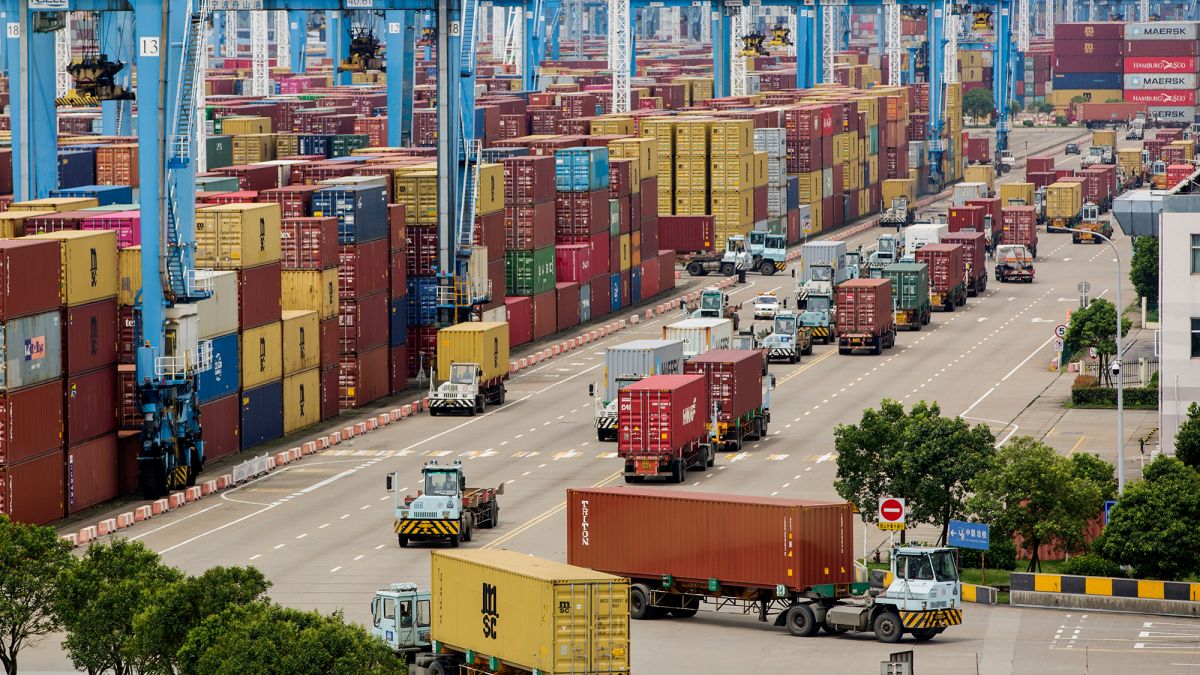Saturday June 28, 2025 4:00 pm
Saturday June 28, 2025 4:00 pm
ECONOMYNEXT – The global economy faces a sharp slowdown induced by the most severe trade war since the 1930s, Fitch Ratings has said.
“The recent de-escalation in US-China trade tensions has led Fitch Ratings to make broad-based upward revisions to its global growth forecasts compared to the previous Global Economic Outlook (GEO) published in mid-April,” Fitch said.
“But the world economy still faces a sharp slowdown induced by the most severe trade war since the 1930s,” Fitch said in its June 2025 Global Economic Outlook published this week.
Fitch now forecasts world GDP growth at 2.2 percent in 2025, an upward revision of 0.3pp since the April GEO.
“These rates are well below the 2.9% recorded in 2024 and the longer-term average of 2.7%.”
The ratings agency said the US recession risks were receding, but there were signs of an underlying slowdown in final domestic demand and consumption.
“The tariffs have reduced US business and consumer confidence.”
Recent oil price volatility adds further upside inflation risks, Fitch said. (Colombo/Jun28/2025)
Sunday June 29, 2025 7:03 am
Sunday June 29, 2025 7:03 am
ECONOMYNEXT – Sri Lanka’s apparel exports to the US dropped 7.59 percent in May 2025, amid Trump tariff uncertainty, but shipments to other markets, allowed the almost the same revenues to be maintained, Joint Apparel Association Forum said.
Exports to UK also fell 6.18 percent, but EU had grown 5.15 percent, while other markets grew 11.1 percent almost maintaining last years revenues of 365.08 million which was only 0.63 percent down.
“We are encouraged by the momentum, particularly in emerging and EU markets,” JAAF said in a statement.
“The industry’s year-to-date performance demonstrates resilience and adaptability, driven by strategic market shifts and continued investment in value-added products.
In the five months to May, exports grew 9.8 percent to reach 2.02 billon US dollars.
Exports to the EU (except UK) grew 15.6 percent in the first five months, followed by 13.12 percent growth in non-traditional markets.
Shipments to the USA were still up with 6.52 percent growth up to May despite the April dip and UK also grew 3.74 percent,
“To sustain this progress, JAAF reiterates the importance of a stable and predictable trade policy environment that enables long-term competitiveness and supports exporters navigating global headwinds.”
Sri Lanka has negotiated with the US to try and avoid a situation where the country will end up with a taxes higher than competitors. (Colombo/June29/2025)
Continue Reading
Saturday June 28, 2025 11:43 am
Saturday June 28, 2025 11:43 am
ECONOMYNEXT – Batteries for solar power are hit with 46 percent in taxes at the point of import making them expensive in Sri Lanka compared to other countries, the island’s renewable energy industry group has said.
Sri Lanka’s Ceylon Electricity Board has announced a 45.80 rupee a unit tariff for solar batter energy stored during the day and discharged into the grid between 630 pm and 1030 pm.
But the taxes increased the capital cost of batteries artificially the Federation of Federation of Renewable Energy Developers (FRED) said.
The import duty was around 25 percent, there was 5 percent para tariff called port and airport levy and value added tax of 18 percent.
Because electricity is not under Sri Lanka’s value added tax regime, the developers cannot recover the VAT unlike in other sectors by invoicing the CEB, FRED officials said.
At one time solar power inputs were free of some taxes but after the economic crisis, industry officials said but after last economic crisis the tax exemptions were tightened.
Unlike in export-oriented countries in East Asia like Vietnam and Singapore, electricity is not charged VAT in Sri Lanka for reasons that are not clear.
The renewable energy developers therefore gets stuck with the VAT as a capital cost. Some large FDI projects however get VAT relief up front.
Based on information available, the CEB is planning to give only 10 years for the battery tariff, compared to a 20-year Power Purchase Agreement, FRED officials said.
“So in order to make it commercially sensible, it has to be 20 years,” a FRED official said.
“And the batteries are now available in the storage battery with about 12,000 cycles. We can use more than 15, 20 years.”
The FRED is also protesting a recent reduction in feed-in-tariffs for renewables from June, which they say will discourage private developers.
RELATED
Sri Lanka to pay Rs45.80 a unit for battery solar power in the night
Sri Lanka renewable energy feed-in-tariffs reduced from June 2025
The feed-in-tariffs were decided by a committee and approved by the cabinet of ministers. While the renewable developers made representations, they have not been adequately taken note of, FRED officials said.
Especially in rooftop solar, feed-in-tariffs have been successful in getting about 1,700MW of rooftop solar, while competitive bidding have not, FRED said. (Colombo/June28/2025)
Continue Reading
Saturday June 28, 2025 9:34 am
Saturday June 28, 2025 9:34 am
ECONOMYNEXT – Sri Lankans with re-entry visas who returned from Israel during the recent flare up of hostilities with Iran can return till July 31, the Foreign Ministry said.
The Population and Immigration Authority (PIBA) of Israel has decided to extend the validity the re-entry visa of those who have come to Sri Lanka visa with the hope of returning to their employments in Israel.
“As international flights to Israel have started presently, those who came to Sri Lanka on re-entry visa have the possibility to return to work in Israel until 31.07.2025 even after the expiry of the re-entry visa,” the Foreign Ministry said.
Israel and Iran are observing a ceasefire, following US intervention.
Israel attacked Iran and hitting nuclear facilities, assassinating scientists and the senior military figures, triggering return fire from missiles and drones. The US also bombed some nuclear facilities at the end.
Iranian ballistic missiles in particular, penetrated Israel defences. (Colombo/June28/2025)
Continue Reading









Leave a Reply